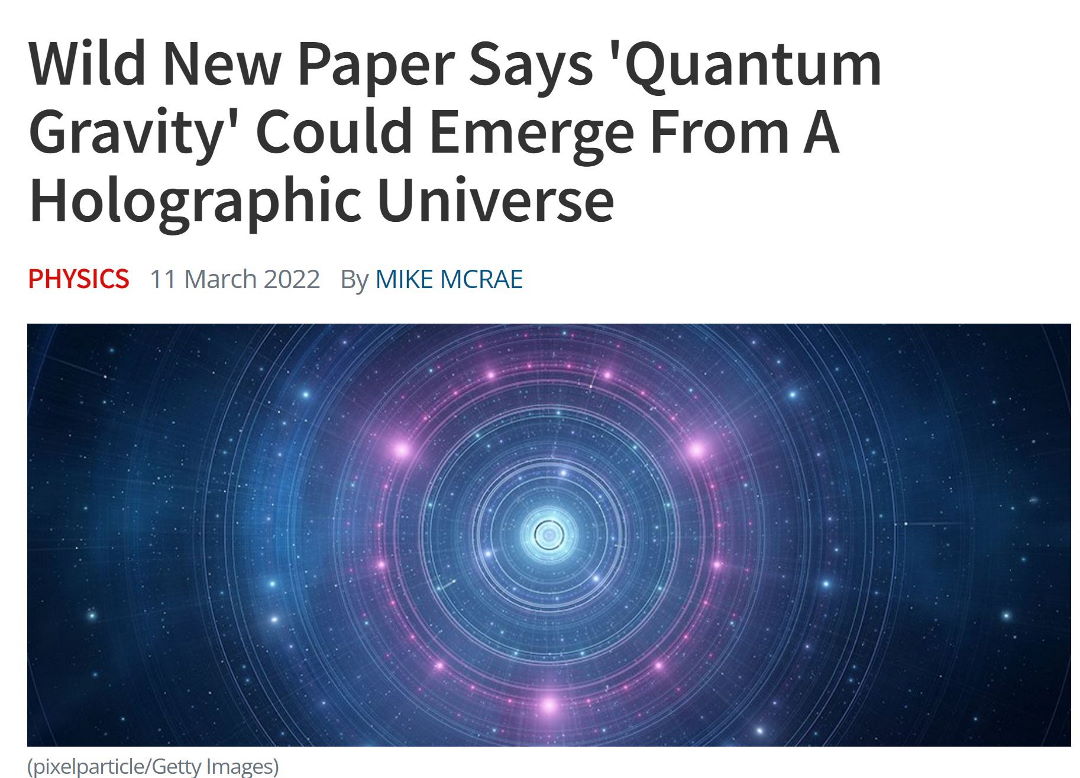Kuran’da Levh-i Mahfuz ‘Korunmuş Levha’ olarak bizlere tanıtılan, korunmuş/ulaşılmaz/içeriği değiştirilemez olan ve içinde bilgi saklayan bu yapının evrenimizi bir üst boyuttan saran 2 boyutlu zar (membrane) olduğunu daha önceki makalelerimizde görmüştük.
- Levh-i mahfûz nedir? Korunan bir levha.
- Ruh: Levh-i mahfûzdan (evrenimizi bir üst boyuttan saran ve tüm kuantum bilgilerinin saklı olduğu 2 boyutlu zar) evrene yansıma.
- Kuran evrenin düz (‘flat universe’) olduğunu 1400 yıl önceden haber veriyor.
Bu zardaki önceden Yüce Allah tarafından kaydedilen bilgilerden evrenin tümüne ‘ruh’ aracılığı ile bilgi yansıtılıyor ve kuantum alanındaki farklı kanatlı/boyutlu (faklı boyutlarda titreşen) sicimlere iletiyordu.
Bu sicimlerin titreşimi ile atom altı parçacıklar oluşuyor ve tüm evren canlanıyordu. Işık hızında 3 boyutlu bir yazıcı gibi düşünün. Bilgi anında 3D objelere dönüşüyor.
Holografik evren prensibine göre tüm evren bir hologramdır. Yani bir yansımadır. Kuran da aynısını söylüyor. Levh-i Mahfuz’daki bilginin 3D uzay-zaman alanına yansıması.
Kuran dikkatli bir şekilde ve fizik bilimine hakim bir şekilde okunduğunda aşağıdaki teorileri işaret ettiği rahatlıkla görülebilir.
- Holografik evren
- Düz ‘Flat’ evren
- Sonsuz ‘Infinite’ evren
- Süper-simetrik sicim teorisi
- Big Bouce ‘Büyük Sıçrama’
Bu kısa bilgileri vermemin nedeni 2022 yılında yayınlanan bir makaledir.
Çok yeni yayınlanan bu makalede Kuantum Yerçekiminin ‘Quantum Gravity’ holografik evrenden kaynaklanabileceği matematiksel olarak gösterildi. Gerçekten büyük bir ilerlemedir. Matematiksel modeller biliyoruz ki gerçekte mevcut olan fizik kurallarını onları keşfetmeden önce açıklar.
Makalenin Holografik evreni destekler yansıması için yazılan yazı;

In the last decades of his life, Albert Einstein hoped to unite his description of gravity with existing models of electromagnetism under a single master theory.
It's a quest that continues to vex theoretical physicists to this day. Two of our best models of reality – Einstein's general theory of relativity and the laws of quantum mechanics – are as immiscible as oil and water.
Whatever a combination of the two looks like, it will almost certainly reveal foundations to the Universe quite unlike anything we can visualize.
A newly published mathematical discovery describes the emergence of gravity within a so-called 'holographic' model of the Universe; it was found by a team of researchers from Chalmers University of Technology in Sweden and MIT in the US.
Strange as it might sound, it's the best place for us to start in our search for a complete understanding on how space, time, and matter all emerge from deeper laws.
"When we seek answers to questions in physics, we are often led to new discoveries in mathematics too," says Chalmers University mathematician, Daniel Persson.
"This interaction is particularly prominent in the search for quantum gravity – where it is extremely difficult to perform experiments."
Despite their discrete ability to predict the behavior of everything from electron jumps to black hole bumps with uncanny precision, quantum physics and general relativity arise out of two very different systems of thought.
The quantum Universe is blocky, yet hazy when viewed up close, like pixels that blur into a confusing mess of color when you press your face against the screen.
General relativity relies on a seamless continuum of space and time that curves in response to mass with clear conviction, even when viewed on the smallest of scales.
There are other metaphors we can use to describe how the Universe might operate, each with their own mathematical frameworks, each a little more obscure than the last.
Some involve adding unseen dimensions wrapped up in mind-bending geometries. The holographic principle used by the researchers here is a strange example that involves taking dimensions away.
You can think of it like this: All the information telling how particles push and pull together is encoded on something more akin to a flat surface than the 3D space we think we live in, not unlike how a sense of depth appears when you look at a flat, holographic sticker.
There's a good reason to think of physics this way. Quantum versions of gravity embedded in 4D spacetime quickly become extremely complicated and unworkable.
If our spacetime were to curve far enough back on itself to create a kind of cylinder, it would necessarily have a 'flat' boundary. It also just so happens that those unwieldy theories of quantum gravity would have corresponding theories on this boundary, theories that are a lot simpler to work with.
This new paper effectively mixes different models governing particles and their waves and how they transform in fields within a holographic setting, to land upon the mathematical equivalent of gravity working as a natural consequence of these interactions.
"The challenge is to describe how gravity arises as an 'emergent' phenomenon. Just as everyday phenomena – such as the flow of a liquid – emerge from the chaotic movements of individual droplets, we want to describe how gravity emerges from a quantum mechanical system at the microscopic level," says mathematician Robert Berman, also Chalmers University.
As a bonus, this new work could also point the way to explanations on other large-scale phenomena, such as the Universe-expanding fuel we currently refer to as dark energy.
Elegant as the mathematics might be, theorists have the luxury of filling their work with caveats and assumptions in order to find intriguing new patterns. For example, whether our Universe curves back on itself enough to have the kind of boundary necessary for the holographic principle is an open question in itself, one few cosmologists are convinced of.
Still, when you're trying to work out a problem even Einstein couldn't solve, starting with the unimaginable isn't a bad way to begin.
This research was published in Nature Communications.
Konunun ders olarak anlatımı;
En doğrusunu Allah bilir.